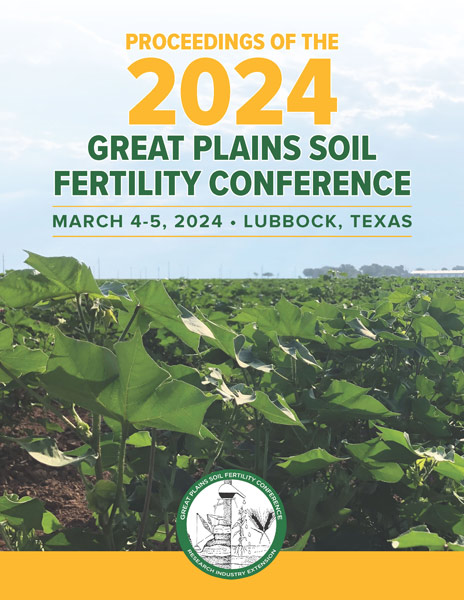Conference Proceedings Available!
Proceedings
Authors
| Filter results8 paper(s) found. |
|---|
1. Observational and Modeling Methods to Inform Ecosystem Service MarketsInterest in quantifying the impacts of land management on ecosystem services has grown as governments, environmental organizations, and corporations have pledged to reduce greenhouse gas emissions, nutrient leaching, and other environmental impacts of human activities. Ecosystem service markets were formalized in the 1990s and originally deployed to mitigate point sources of air and water pollution. Associated protocols were fairly simple and easy to implement because quantification of point sources... S.J. Del grosso, J. Delgado, D. Manter, C. Stewart, M. Vigil |
2. Long-term Crop Rotation Diversity Effects on Soil C and NThe objective of this study was to evaluate the effects of nitrogen (N) fertilizer level and crop rotation diversity on soil organic carbon (SOC) and N stocks from a 34-yr study located in eastern Nebraska. Seven crop rotations (three continuous cropping systems; two 2-yr crop rotations, and two 4-yr crop rotations) and three N levels were compared. Soil samples were taken to a depth of 60-inches. Differences in SOC stocks were largely confined to the 0 to 3-inch depth with greater SOC (P =... M. Schmer, V. Jin, B. Wienhold, G. Varvel |
3. Inter-seeding Cover Crops Influence on Optimal Corn Nitrogen Rate in No-tillMoving from conventional to no-till with the inclusion of cover crops may change the amount and timing of nitrogen (N) provided to corn (Zea mays L.) from mineralization, which may increase or decrease needed N fertilizer to optimize corn grain yield. This study evaluated the effect of cover crop composition on corn N fertilizer requirement and corn grain yield. The effect of three cover crop treatments (no cover crop, single grass species, and grass/broadleaf mixture) on corn... J. Clark, S. Osborne, P. Kovacs, R. Slaght |
4. In-season Nitrogen Application Method Influence on Grain Sorghum PerformanceGrain sorghum production in the United States is concentrated in the great plains. This region is prone too harsh environments that may provide opportunities for extensive N losses when relying on pre-plant N application alone. This problem may be alleviated through moving N application later in the growing season to optimize N availability when plant N uptake is most required to prevent yield loss. However, fertilizer application equipment availability may be limited for many producers in the... R.L. Sharry, B. Arnall |
5. Effects of Phosphorus and Potassium Application Timing on a Wheat Double Crop Soybean SystemThe wheat-double crop soybean system is a popular choice for Oklahoma producers, as it allows for two crops in one year, and therefore, more revenue in less time. With favorable conditions and proper management, double crop soybeans are yielding as well as full season soybeans. Weather pattern shifts over the last few years have raised the question for growers if they should invest more into the summer double crop, as there is growing potential for profit. While attempting... H. Lovewell, B. Finch, R. Sharry , M. Smith, J. Souza, B. Arnall |
6. Evaluation of N Source in No-till Winter WheatNitrogen (N) source efficacy is dependent upon product used, application timing, and the condition of the environment in which it is placed. This study serves to look at how different N sources can be affected across different regions of Oklahoma, specifically in a heavy residue, no-till environment. N sources that were included in the study were Urea, Urea-Ammonium Nitrate (UAN), UAN + Anvol, and SuperU. The N sources were evaluated across nine site-years (SY) where each product had four... J. Derrick, B. Arnall, M. Smith, J. bigatao souza |
7. Composted Manure Impacts on Organic Wheat Production in the Northern Great PlainsMontana leads the nation in organic production of small-grain crops including wheat (Triticum spp.). A major challenge faced by dryland farmers when growing wheat organically is supplying adequate N for optimum wheat yield and quality. A onetime application of composted manure at four rates (0, 5.6, 11, and 22 tons/acre) vs. annual applications of urea based on soil test results when growing wheat in wheat/fallow and wheat + biennial sweetclover [(Melilotus officinalis (L.)... P. Carr, M.M. Volkman |
8. Developing Nitrogen and Phosphorus Fertigation Strategies in CottonSubsurface drip irrigation (SDI) is becoming a popular option for maximizing the water use efficiency of cotton (Gossypium hirsutum), especially in semi-arid environments of the Midsouth and Western United States. In the Texas High Plains where underground water resources from the Ogallala Aquifer are rapidly declining, there is increased adoption of water conservation technologies like center pivot and drip irrigation. In addition to increased water efficiency, drip irrigation allows... K. Lewis, H. Valencia, T. Roberts, J. Burke, G. Ritchie |
